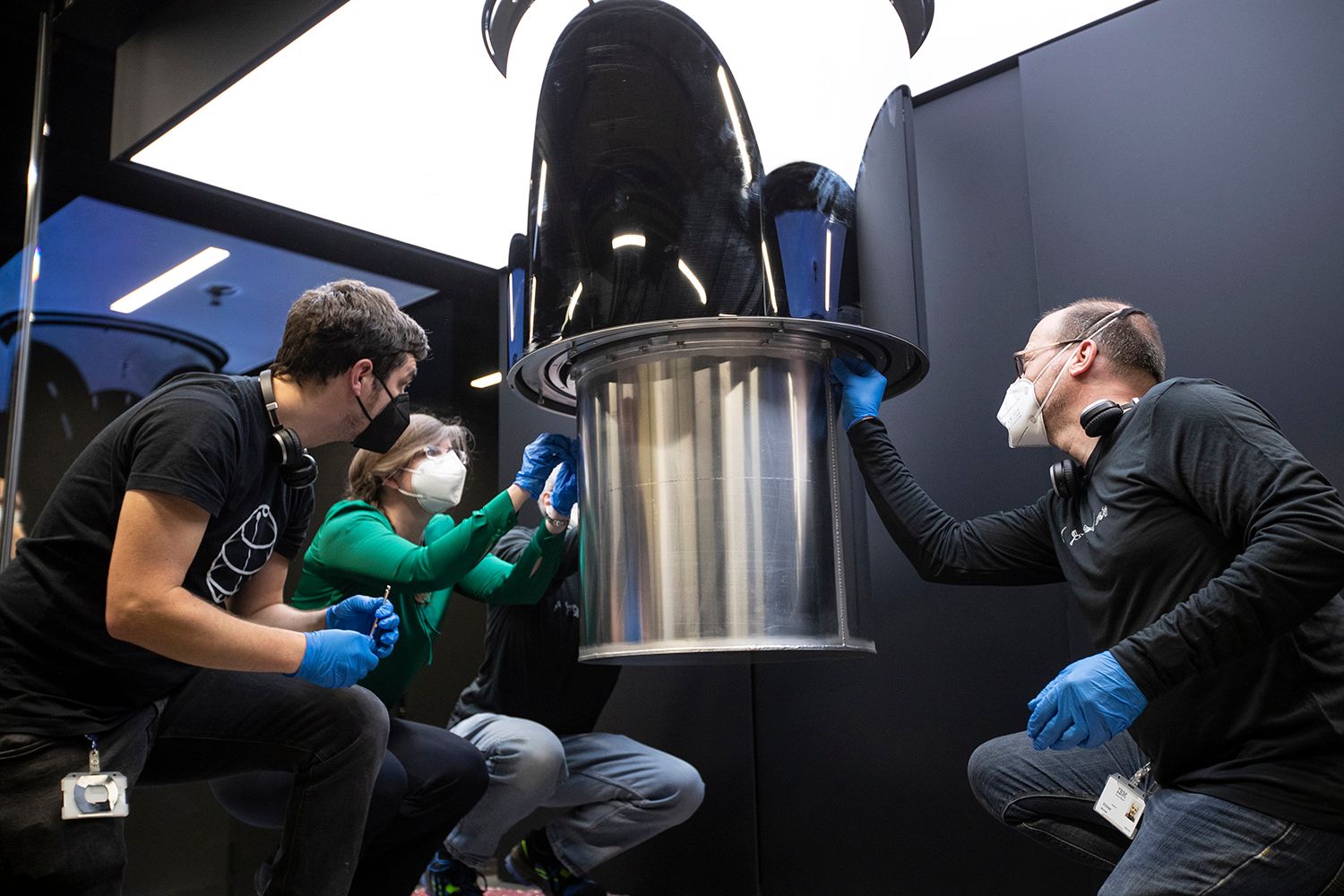The technical foundation of the IBM-Fraunhofer Institute collaboration is Europe's most powerful commercial quantum computer and IBM's first Quantum System One outside of the US. It provides full European data locality.
Watch the replay of June 15 event: A Quantum Computing Journey in Germany
Fraunhofer-Gesellschaft is betting that Quantum System One will pave the way to future industrial applications of this new way of computation. It should also lead to ever more research and help develop a global quantum-ready workforce. It’s the first step towards commercially scaling IBM’s quantum computing technology. In July, a quantum computer in Japan will join its Fraunhofer cousin, and in the not too distant future one will also be installed at Cleveland Clinic in Ohio.
“Quantum computing opens up new possibilities for industry and society,” says Hannah Venzl, the coordinator of Fraunhofer Competence Network Quantum Computing. “Drugs and vaccines could be developed more quickly, climate models improved, logistics and transport systems optimized, or new materials better simulated. To make it all happen, to actively shape the rapid development in quantum computing, we need to build up expertise in Europe.”
Indeed—in Europe
, and the world, too.Building up expertise is vital to create a quantum industry. We expect that within the decade, we will achieve a “quantum advantage”—the point when quantum computers will provide more-accurate, computationally cheaper solutions; or even allow us to calculate solutions to problems we can't solve today. When that happens, these machines are likely to change the world. But the world needs to be ready for them—with a skilled, creative, results-driven talent.
That’s our quantum future—and with these machines now starting to pop up across the globe, it may be closer than you think.
Tackling the quantum talent shortage
Fraunhofer’s new addition is mirror-black and shiny. Behind the system’s giant doors, made of the same glass protecting the Mona Lisa in the Louvre, there is a cylinder-like structure. Inside is the 27-qubit Falcon processor, IBM's most-advanced, hard-tech quantum processor. It's kept at a temperature colder than outer space, with qubits that have long coherence times—how long they remain in their quantum state—and precise, low-noise operations of about 10-20 watts.
While Fraunhofer is the first place outside the US to have an IBM Quantum System One, the interest in quantum technologies has been steadily growing over the past decade. Nearly all continents now have quantum computing startups, and many tech giants in addition to IBM are making strides in the field. In total, the global market for quantum technologies could soon reach nearly $22 billion.1
But here is the thing. While investments in research and the research itself are important, they are not enough. There is a disconnect between the development of a quantum computer and its wide-scale commercialization.
Only a fraction of businesses are getting quantum-ready. The vast majority of companies still do not have the workforce able to use quantum computers, to do any kind of quantum programming, or even have an idea how a quantum computer could help them. There is little on-the-job quantum training and few hires with quantum computing skills.
That’s why partnerships like the one between IBM and Fraunhofer are crucial—even though it’s not necessary to buy a quantum computer to access one. Currently 150 organizations in IBM’s Quantum Network including research labs, start-ups, universities and enterprises access IBM’s quantum fleet via the cloud. Still, being able to have the machine on premises helps with processing more data, locally.
Fraunhofer’s System One, which came online a few weeks ago for testing, is already hard at work. Focusing on quantum optimization, researchers here in Germany have started exploring new simulation approaches for materials in energy storage systems. Another project being actively studied by the local researchers is to better-optimize financial asset portfolios and improve the stability parameters in energy supply infrastructures. They even aim to use the quantum computer to push the limits of deep learning with quantum machine learning.
“At Fraunhofer, we have more than 70 years of expertise in applied research and industrial projects, and we are closely interlinked with industry,” says Venzl. “The training on the system will help us develop practical applications and build up important competencies in German industry and at Fraunhofer itself.”
The ball at Fraunhofer is definitely rolling—but getting the machine here was anything but trivial.
Building a quantum computer… remotely

IBM Germany engineers working on the IBM Quantum System One.
The COVID-19 pandemic intervened in the assembly, and it had to be done remotely.
“I was on site in October 2019 where I had the chance to interact directly with the team doing local design work, get everyone involved—electricians, to plumbers—and walk through the plans in detail,” says Chris Lirakis, IBM quantum lead for quantum systems deployment, who is based at IBM’s Yorktown Heights lab near New York City. “It's the only way that you can read people’s body language, take cultural and language differences into account.”
Lirakis’s plans, though, got derailed.
The pandemic meant it wasn’t possible for anyone from the US team to fly to Germany. So the IBMers had to resolve to NASA-inspired techniques of remote assembly, taking the remote working practices of this pandemic to the extreme.
From 4,000 miles away, the US team worked with German engineers from the local IBM development lab to install the cryostat, a specialized refrigeration system, and the delicate IBM Falcon quantum processor.
One of the crates shipped was custom-built to withstand vibration isolation, with shock absorbing material and brackets that could be bolted down, making the entire crate impossible to tip over.
The IBM team in Germany that created the 'hub' of the Quantum System One in Ehningen, a town half an hour drive from Stuttgart, initially had no experience in assembling the full system. So Lirakis and his colleagues set up an in-depth course in quantum assembly for the German engineers. This way, several hours a day for a few weeks, they were locked in a virtual classroom. The US team had to be on a video conference call with the Germans at 2:00 a.m., at the start of the day in Stuttgart.
On a lighter note, on Fridays the two teams happily cracked open beers at the end of day—lunchtime on the US east coast. Still, they pulled it off, and the quantum computer came online according to the original, pre-COVID schedule in January 2021.
Getting quantum-ready—early
While the quantum system is for Fraunhofer, it’s possible for scientists and students outside the institute to use it too, for civil research and education. Access requires a contract, and the use is on the basis of a monthly ticket, giving partners flexibility without a long-term commitment.
Every new researcher that gets their hands on the machine, in the lab or through the cloud, will contribute to turning the trickle of quantum talent into a flood, vital for the emerging quantum era. We need more collaborations like these, between researchers and students, to create a diverse quantum-ready workforce, with careers in quantum technologies of the future.
The key word here is “diverse.”
Scientists and students using quantum computers shouldn’t just be physicists or programmers, which is often the case today. A successful quantum ecosystem of tomorrow needs quantum computing engineers, computer scientists, technicians, experts in optics and photonics, and even economists, market leaders and communicators.
We need skilled quantum programmers to create libraries of quantum algorithms for specific problems in different fields. But we also need quantum experts to further improve software and hardware, to advance core quantum computing technology. And we need businesses to have enough quantum awareness to realize that a quantum computer would help them significantly improve output and possibly create products they can’t create today.
As the technology and the ecosystem mature, thousands of new jobs will appear. We need to address today’s quantum talent shortage, ensuring there is enough skilled, clever people to fill them. We have to get the world ready before the technology is ready, to reap the most rewards.
More collaborations like the one with Fraunhofer will help to democratize the quantum industry, and build a vibrant quantum computing ecosystem to make the world quantum-ready—and start shaping our quantum future.
AMA with IBM Quantum and Fraunhofer
Watch our AMA with Fraunhofer on Accessing Europe’s Most Powerful Quantum Computer to learn more about IBM’s Quantum System One and how it can be accessed via the cloud.




